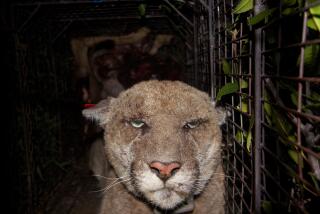Puma found dead in Point Mugu State Park killed by rat poisons
- Share via
A once-photogenic mountain lion whose carcass was found by a runner in Point Mugu State Park on Sept. 30 died of exposure to rat poisons, the National Park Service confirmed Tuesday.
A necropsy of the puma known as P-34, conducted by scientists at the California Animal Health and Food Safety Lab in San Bernardino, validated the initial suspicions of biologists who found blood running freely inside the dead female.
Rat poisons, or rodenticides, are designed to kill rodents by thinning their blood and preventing clotting. They lead to uncontrollable bleeding.
In addition to proving deadly for their intended targets, these poisons can wreak havoc as they work their way up the food chain. A mountain lion might devour a ground squirrel that consumed the bait or an animal such as a coyote that had eaten another animal with the bait in its system.
“This is the latest indication that local wildlife continues to be exposed to these rodent poisons,” said Seth Riley, a wildlife ecologist who has led a long-term study of mountain lions in the park service’s Santa Monica Mountains National Recreation Area.
Scientists said Tuesday that evidence was mounting that California’s July 2014 ban on retail sales of certain highly toxic rat poisons — called second-generation anticoagulant rodenticides — has not produced the far-reaching benefits that researchers had hoped.
“I thought there would be more improvement than I’m actually seeing,” said Stella McMillin, senior environmental scientist with the California Department of Fish and Wildlife. “We’re still seeing nontarget exposure at pretty high levels.”
Although consumers no longer may buy these “super toxins” off the shelf, agricultural operations regularly use them, as do licensed pest-control companies.
Moreover, other rat poisons still allowed for use by consumers are increasingly showing up in wildlife, said Jonathan Evans, environmental health legal director with the nonprofit advocacy group Center for Biological Diversity in Oakland.
Wildlife deaths continue to demonstrate the “need to ban these products from the market,” he said. He and other activists have met with the California Department of Pesticide Regulation to point out loopholes in the ban.
“We continue to call on state regulators to ban these poisons to protect California’s most iconic and imperiled wildlife,” Evans said. Consumers and businesses, he added, must consider using other rodent-control methods that “do not involve killing predators that are part of the solution.”
P-34, who was not quite 2 years old, showed evidence of exposure to five compounds, “an impressive number,” Riley said.
Last December, P-34 made news when she was discovered lounging under a trailer in a Newbury Park mobile home community. A resident photographed the lion ambling along the top of a wall in her backyard.
P-34’s was the first puma death conclusively linked to rat poisons since 2004, when scientists confirmed that two siblings died because of exposure to the toxic chemicals. Those lions, P-3 and P-4, spent most of their time in the Simi Hills, north of the 101 Freeway.
In 2012, a hiker in Point Mugu State Park found the carcass of a female lion known as P-25. The cause of death was never determined, but toxicity from rat poisons was strongly suspected, given that she showed no sign of disease or having fought with another lion.
P-34’s sibling, the male P-32, was struck and killed by a motorist in August while trying to cross the 5 Freeway near Castaic.
P-32, who was approximately 21 months old, was the only male mountain lion known to have left the Santa Monica Mountains and wandered north into other habitat areas. He had managed to cross the 101 Freeway, State Route 23, Highway 118 and Highway 126.
Park service researchers have documented the presence of rodenticide compounds in 12 of 13 mountain lions they have tested, including a 3-month-old kitten. Scores of bobcats, coyotes and other animals are known to have died from internal bleeding likely caused by the toxins.
In 2014, P-22, the Griffith Park mountain lion, famously developed a case of mange that biologists said was probably caused by exposure to rat poisons. A park service biologist applied a topical treatment and injected Vitamin K to offset the effects. Recent images of P-22 indicate that he remains mange-free.
Twitter: @MarthaGroves
ALSO:
Anyone out there want to claim this $63-million lottery ticket?
L.A. County to pay $1.3 million over doctor who molested patients
Shootings by LAPD double in ‘alarming’ trend, police commission president says
More to Read
Sign up for Essential California
The most important California stories and recommendations in your inbox every morning.
You may occasionally receive promotional content from the Los Angeles Times.










